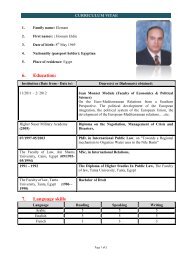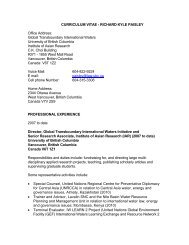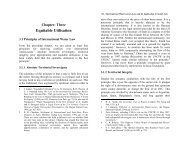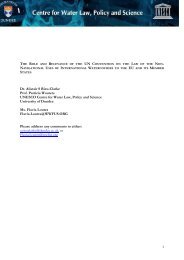Upreti, Trilochan, International Watercourses Law and Its Application ...
Upreti, Trilochan, International Watercourses Law and Its Application ...
Upreti, Trilochan, International Watercourses Law and Its Application ...
You also want an ePaper? Increase the reach of your titles
YUMPU automatically turns print PDFs into web optimized ePapers that Google loves.
188 / <strong>International</strong> <strong>Watercourses</strong> <strong>Law</strong> <strong>and</strong> <strong>Its</strong> <strong>Application</strong> in South Asia Prospects <strong>and</strong> Problems of Nepalese Water Resources / 189(UP) at her own cost <strong>and</strong> initiative, <strong>and</strong> so it was natural forIndia to accrue benefits for herself. However, an assessment ofthe treaty provisions seems to indicate that much of the benefitswent to India inequitably, since Nepal swapped its ownterritory with India to make this project feasible; sucharrangements are rarely encountered in international water caselaw elsewhere.Another water resource project involving Indo-Nepal cooperation,the first to be undertaken after the independence ofIndia, was the Kosi Project Agreement, being a multipurposescheme including hydropower generation (20,000 KW).However, a major component of the project was flood control<strong>and</strong> irrigation, the so-called "sorrow of Bihar" 28 , whichannually caused tremendous loss of lives <strong>and</strong> property severaltimes mainly in India, but also in Nepal. The project wasconceived <strong>and</strong> several studies were undertaken from 1946;however, by 1954 it was considered urgent to implement theproject in order to eliminate <strong>and</strong> mitigate the recurrent <strong>and</strong>devastating effect of the Kosi flood during the monsoon season.The Kosi scheme consisted of a canal system, flowing channelson both sides, a barrage across the river <strong>and</strong> a hydro station.The barrage consisted of 56 gates <strong>and</strong> was 3770 feet long. Thepurpose of its construction of the barrage was to minimise theerosion of soil <strong>and</strong> deposit of silt. 29 For the project,embankments were constructed on both sides of the riverextending for about 130 km downstream almost up to theconfluence of Kosi with the Ganges, to ensure flood protectionof approximately 280,000 ha of l<strong>and</strong>; a diversion structure wasalso built for a network of canals to provide irrigation to a totalof 1,150,000 ha of l<strong>and</strong>. 30 However, the project was seriouslycriticised at all levels in Nepal, the complaint being that it was asell out of national property for India’s benefits <strong>and</strong> thatnothing had been obtained for Nepal in return for a hugeexpenditure of resources. Political unrest <strong>and</strong> generalresentment within Nepal resulted from this outcry. Eventually,India agreed to reconsider, 31 <strong>and</strong> the revised agreement inwhich some of Nepal’s concerns were accommodated wassigned on 19 December 1966. Thus, in view of the assurance ofthe then Indian Prime Minister Lal B. Sastri, Nepal agreed toresume work on the project. Pursuant to the revised agreement,some arrangements were changed to assure Nepal's 32 benefit:• Any construction or other undertaking by India inconnection with the Kosi Project was to be planned <strong>and</strong>carried out in consultation with the NepaleseGovernment. Nepal was to provide facilities to theIndian officials necessary for surveys <strong>and</strong> investigationsinside the project area, for the maintenance <strong>and</strong>operation of the project.• The l<strong>and</strong> needed for construction works was to beleased to the Indian government in return forcompensation payments.• It was agreed that Nepal should have the right towithdraw water from the Kosi <strong>and</strong> its tributaries as <strong>and</strong>when required.• The Government of Nepal would be entitled to obtainfrom India, for use in Nepal, up to 50% of the totalhydroelectric power generated by any powerhousesituated within a ten-mile radius of the barrage site.• The l<strong>and</strong> acquired <strong>and</strong> leased to India, which wasinitially given for an unlimited period, was now to be28 Ibid.29 Ibid. pp 95-98; also see supra note 17, pp. 200-202.30 T. Prasad, "Comprehensive Water Resources Development in Indo-Nepal Region: Perspectives <strong>and</strong> Prospects” presented at a conferenceon Large Scale Water Management held in Kathm<strong>and</strong>u, 1997, p. 18.31 Ibid. Also note that the Indian Power <strong>and</strong> Irrigation Minister, K. L. Raogave assurances that the Treaty would be revised in 1962-63 during hisvisit to Nepal <strong>and</strong> in 1965 during the visit of Prime Minister Lal B.Sastri visit this was again assured, supra note 17, pp. 100-101.32 Ibid. pp. 100-102.












